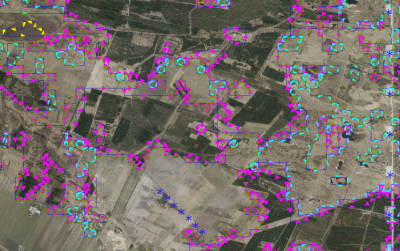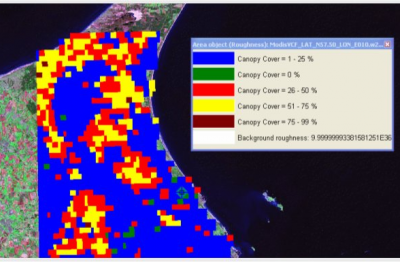Category:Digital Roughness Data: Difference between revisions
No edit summary |
mNo edit summary |
||
| (5 intermediate revisions by the same user not shown) | |||
| Line 1: | Line 1: | ||
[[Category:Online Data]] | [[Category:Online Data]] | ||
The digital roughness models in WindPRO are based on open internet resources | [[Image:OesterildTestCenter_CGLC100m.png|right|400px|thumb|Roughness from Copernicus Global Land Cover 100m - At Østerild Test Center, Denmark.]] | ||
[[Image:ModisVCFPic.png|right|400px|thumb|Modis VCF Data for the North-Eastern Part of Jutland, Denmark.]] | |||
The digital roughness models in WindPRO are mainly based on land-cover maps from open internet resources. The setup in windPRO provides an estimate of the roughness lengths or roughness classes based on remote sensing sources or land use databases. The roughness length is typically found from a lookup table (LUT) that translates a land-cover classification into a roughness length. | |||
==A Word Of Caution == | ==A Word Of Caution == | ||
Note, that these sources - when considering wind energy applications - are typically not sufficient for a detailed and accurate roughness classification of a site. However, they may prove helpful for an initial analysis and as support for a more detailed analysis. Especially, the roughness levels assigned to the digitized areas need to be verified and normally needs adjustments by the user. | Note, that these sources - when considering wind energy applications - are typically not sufficient for a detailed and accurate roughness classification of a site. However, they may prove helpful for an initial analysis and as support for a more detailed analysis. Especially, the roughness levels assigned to the digitized areas need to be verified and normally needs adjustments by the user. | ||
Latest revision as of 12:47, 8 June 2020


The digital roughness models in WindPRO are mainly based on land-cover maps from open internet resources. The setup in windPRO provides an estimate of the roughness lengths or roughness classes based on remote sensing sources or land use databases. The roughness length is typically found from a lookup table (LUT) that translates a land-cover classification into a roughness length.
A Word Of Caution
Note, that these sources - when considering wind energy applications - are typically not sufficient for a detailed and accurate roughness classification of a site. However, they may prove helpful for an initial analysis and as support for a more detailed analysis. Especially, the roughness levels assigned to the digitized areas need to be verified and normally needs adjustments by the user.
Pages in category "Digital Roughness Data"
The following 9 pages are in this category, out of 9 total.